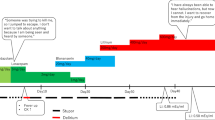Abstract
Convulsive therapy (COT) is a major European contribution to the psychiatric armamentarium and biological psychiatry. COT was introduced in psychiatry by László Meduna, a Hungarian neuropsychiatrist. All subsequent publications about the first patient treated with COT, Zoltán L (ZL), were based on Meduna’s papers and autobiography. After 4 years of catatonic stupor, ZL received camphor-induced COT which resulted in full remission and discharge from the institution. The aim of this paper is to reconstruct ZL’s case history from the original case notes—partly written by Meduna himself—which were recovered from the archives of the National Institute of Psychiatry and Neurology. The case notes show that ZL repeatedly received COT between 1934 and 1937, first with camphor and then with cardiazol induction. After the first course of COT the catatonic stupor was resolved and the psychotic symptoms subsided. However, the remission lasted for only a few months and was followed by a relapse. Despite repeated courses of COT, ZL never became symptom free again, was never discharged and died in the Institute in 1945. This historical case is discussed from both the diagnostic and therapeutic points of view, and an attempt is made to explain the possible reasons for the discrepancies found between Meduna’s account and ZL’s case notes.
Similar content being viewed by others
References
Baran B, Bitter I, Fink M, Gazdag G, Shorter E (2007) Károly Schaffer and his school: the birth of biological psychiatry in Hungary, 1890–1940. European Psychiatry 2007 Dec 8; [Epub ahead of print]
Berrios GE (1997) The scientific origins of electroconvulsive therapy: a conceptual history. Hist Psychiatry 8:105–119
Berrios GE (1997) The origins of psychosurgery: Shaw, Burckhardt and Moniz. Hist Psychiatry 8:61–81
Board of Control for England & Wales (1939) The Twenty-fifth Annual Report of the Board of Control, 1938. London, HMSO
Chanpattana W, Andrade C (2006) ECT for treatment-resistant schizophrenia: a response from the Far East to the UK NICE report. J ECT 22:4–12
Fink M (2001) Convulsive therapy: a review of the first 55 years. J Affect Disord 63:1–15
Fink M (2004) ECT: serendipity of logical outcome? Psychiatric Times January 1, vol 21, no 1
Fink M (2004) Induced seizures as psychiatric therapy. J ECT 20:133–136
Fink M (1984) Meduna and the origins of convulsive therapy. Am J Psychiatry 141:1034–1041
Fink M, Taylor MA (2003) Catatonia: a Clinician’s Guide to Diagnosis and Treatment. Cambridge University Press, Cambridge
Fink M, Taylor MA (2001) The many varieties of catatonia. Eur Arch Clin Neurosci 251(Suppl 1):8–13
Hechst B (1931) Zur Histopathologie der Schizophrenie mit besonderer Berücksichtigung der Ausbreitung des Prozesses. Z Ges Neurol Psychiatr 134:163–267
Kalinowsky LB (1986) History of convulsive therapy. Ann N Y Acad Sci 462:1–4
Klaesi J (1922) Über die therapeutische Anwendung der “Dauernarkose” mittels Somnifen bei Schizophrenen (in German). Z Ges Neurol Psychiat 74:557
Meduna L (1985) Autobiography. Convulsive Ther 1:43–57, 121–138
Meduna L (1954) The convulsive treatment: a reappraisal. J Clin Exp Psychopathol 15:219–233
Meduna LJ (1934) Über experimentelle Campherepilepsie. Arch Psychiat Nervenkr 102:333–339
Meduna L (1937) Die Konvulsionstherapie der Schizophrenie. Carl Marhold Verlagsbuchhandlung, Halle
Nyírő G, Jablonszky A (1929) Some data concerning the prognosis of epilepsy, with special attention to constitution. (Néhány adat az epilepszia prognosisához, különös tekintettel a constitutióra). Orv Hetil 28:679–681
Passione R (2004) Italian psychiatry in an international context: Ugo Cerletti and the case of electroshock. Hist Psychiatry 15:83–104
Sakel M (1933) Neue Behandlung der Morphinsucht. (Eine Insulinkur beseitigt die Abstinentenzerscheinungen durch Ausgleich des während der Entziehung gestörten Gleichgewichtes im vegetativen Nervensystem)(in German). Zschr Neurol Psychiat 143:506–534
Shorter E, Healy D (2007) Shock Therapy: the History of Electroconvulsive Treatment in Mental Illness. Rutgers University Press, New Brunswick
Tharyan P, Adams CE (2002) Electroconvulsive therapy in schizophrenia. Cochrane Database System Review, 2002 (2):CD000076
Whitrow M (1993) Julius Wagner-Jauregg (1857–1940). Smith-Gordon, London
Author information
Authors and Affiliations
Corresponding author
Rights and permissions
About this article
Cite this article
Baran, B., Bitter, I., Ungvari, G.S. et al. The beginnings of modern psychiatric treatment in Europe. Eur Arch Psychiatry Clin Neurosc 258, 434–440 (2008). https://doi.org/10.1007/s00406-008-0816-9
Received:
Accepted:
Published:
Issue Date:
DOI: https://doi.org/10.1007/s00406-008-0816-9




